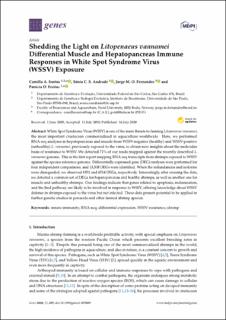Shedding the light on Litopenaeus vannamei differential muscle and hepatopancreas immune responses in white spot syndrome virus (WSSV) exposure
Peer reviewed, Journal article
Published version

Åpne
Permanent lenke
https://hdl.handle.net/11250/2669732Utgivelsesdato
2020Metadata
Vis full innførselSamlinger
Originalversjon
Santos, C., Andrade, S., Fernandes, J. M. de O. & Freitas, P. (2020). Shedding the light on Litopenaeus vannamei differential muscle and hepatopancreas immune responses in white spot syndrome virus (WSSV) exposure. Genes, 11(7). doi: 10.3390/genes11070805Sammendrag
White Spot Syndrome Virus (WSSV) is one of the main threats to farming Litopenaeus vannamei, the most important crustacean commercialized in aquaculture worldwide. Here, we performed RNA-seq analyses in hepatopancreas and muscle from WSSV-negative (healthy) and WSSV-positive (unhealthy) L. vannamei, previously exposed to the virus, to obtain new insights about the molecular basis of resistance to WSSV. We detected 71% of our reads mapped against the recently described L. vannamei genome. This is the first report mapping RNA-seq transcripts from shrimps exposed to WSSV against the species reference genome. Differentially expressed gene (DEG) analyses were performed for four independent comparisons, and 13,338 DEGs were identified. When the redundancies and isoforms were disregarded, we observed 8351 and 6514 DEGs, respectively. Interestingly, after crossing the data, we detected a common set of DEGs for hepatopancreas and healthy shrimps, as well as another one for muscle and unhealthy shrimps. Our findings indicate that genes related to apoptosis, melanization, and the Imd pathway are likely to be involved in response to WSSV, offering knowledge about WSSV defense in shrimps exposed to the virus but not infected. These data present potential to be applied in further genetic studies in penaeids and other farmed shrimp species.
